
Microorganisms in action!
- Subject:
- Biology
- Life Science
- Material Type:
- Activity/Lab
- Assessment
- Game
- Lesson Plan
- Provider:
- Arizona State University
- Provider Set:
- Ask A Biologist
- Author:
- Dr. Biology
- Date Added:
- 06/10/2009

Microorganisms in action!
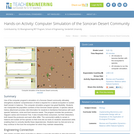
The computer program's simulation of a Sonoran desert community should ultimately strengthen the student's comprehension of what is required for a natural ecosystem to sustain itself (remain in balance). This computer simulation program has great flexibility. It allows the student to manipulate the population numbers of five Sonoran Desert species. A species natural history attachment provides vital information for the students to familiarize themselves with each species' behaviors, its niche and food resource needs. The program includes two producers, the Saguaro cactus and the Ironwood Tree. It also includes 3 consumers, but their interactions both toward the producers and each other differ. The community's ability to remain in balance and sustain all five species so that none die out rests on the student's assessment skills enabling him to correctly identify these dependencies. The student learns by trial and error as he continues to fine tune the ecosystem that he maintains stewardship of.

The purpose of the resource is to produce a land cover type map from the digital file of a Landsat satellite image using MultiSpec software.
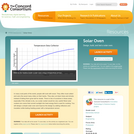
Elementary grade students investigate heat transfer in this activity to design and build a solar oven, then test its effectiveness using a temperature sensor. It blends the hands-on activity with digital graphing tools that allow kids to easily plot and share their data. Included in the package are illustrated procedures and extension activities. Note Requirements: This lesson requires a "VernierGo" temperature sensing device, available for ~ $40. This item is part of the Concord Consortium, a nonprofit research and development organization dedicated to transforming education through technology. The Consortium develops digital learning innovations for science, mathematics, and engineering.
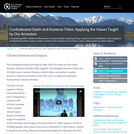
Incorporating elders wisdom in the process of systematically analyzing climate impacts and vulnerabilities in nine categories of tribal life prioritizes actions to take to enhance the evolution of an ancient culture, while protecting tribal traditions.

Explore how populations change over time in a NetLogo model of sheep and grass. Experiment with the initial number of sheep, the sheep birthrate, the amount of energy sheep gain from the grass, and the rate at which the grass re-grows. Remove sheep that have a particular trait (better teeth) from the population, then watch what happens to the sheep teeth trait in the population as a whole. Consider conflicting selection pressures to make predictions about other instances of natural selection.
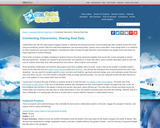
This article describes six collaborative and real data projects that engage elementary students in collecting and sharing local data and communicating with students across the country and world.
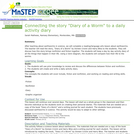
In this activity, you will read the book "Diary of a Worm" and then your students will create their own diary.

This article from the free online magazine Beyond Weather and the Water Cycle provides appropriate science lessons for Grades K-5. The focus is on acquainting young learners with climate-change concepts that are not too complex for their grade level and will not frighten them. In each issue, the magazine develops articles around one of the seven essential principles of climate science. The author believes early lessons about water availability and extreme weather events will prepare students for complex climate concepts they will encounter in later grades.

Dr. Richard Field research interests lie in conservation, biodiversity and the forces that structure ecological communities.
In this podcast, Dr Field from the School of Geography compares and contrasts his experiences as a researcher in national parks in Honduras and Indonesia, and the different types of ecological communities he has studied, and goes on to introduce the emerging field of conservation bio-geography.

This book fosters the recognition of options for making progress toward increased environmental conservation through an understanding of the underlying science and practice of a variety of conservation techniques. Today, there are expected benefits from integrated science and practice, and many people are promoting this as the way forward to improve our environment. Over time, trends emerge regarding the best way to conserve the environment, but so far an outstanding solution has not emerged. Each conservation technique has its foundational concepts, limitations, and implementation issues. Reviewing a collection of techniques provides a basis for considering which approach will be best for any specific environmental challenge. This book should advance the recognition of the challenges managing the environment, techniques that can be used to address the challenges, and the ways they might help foster the integration of science and the practice of ecological conservation.
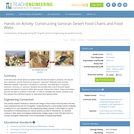
Is the food chain shown above accurate? Does the first link depict a producer, the second link a herbivore, and the third link an omnivore / carnivore? Students must correctly determine whether a species is a producer or consumer, and what type of consumer; herbivore, omnivore, or carnivore. Students are provided with a list of Sonoran Desert species and asked to construct, within their groups, several food chains. These food chains are then be used to construct a food web. In order to complete this activity, students must first research the individual species to understand their feeding habits.

The purpose of this activity is to construct a model that will provide students with a visual representation of parts per billion. Students work in teams to construct cubes of different volumes and to compare them to get a feel for parts per million by volume and parts per billion by volume. The intended outcome is that students gain a feeling for the small quantities of gases, such as ozone, present in the Earth's atmosphere.

This online quiz on sustainable development can be used in French language classes to prepare intermediate-level students for discussions on environmental topics. The resource is excellent for immersion and content-based instruction.
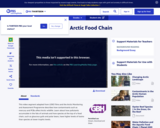
The levels of contaminants found in particular animals vary widely depending on where they fit into the Arctic food chain, as described in this video segment adapted from LOKE Films and the Arctic Monitoring and Assessment Programme.
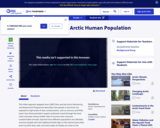
In this video segment adapted from LOKE Films and the Arctic Monitoring and Assessment Programme, learn how human populations in the Arctic are affected by industrial contaminants in the food chain.
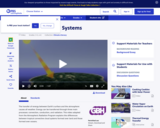
This video segment adapted from the Atmospheric Radiation Program explains the differences in the formation of tropical convective cloud systems over islands and over the ocean.
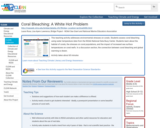
This teaching activity addresses environmental stresses on corals. Students assess coral bleaching using water temperature data from the NOAA National Data Buoy Center. Students learn about the habitat of corals, the stresses on coral populations, and the impact of increased sea surface temperatures on coral reefs. In a discussion section, the connection between coral bleaching and global warming is drawn.
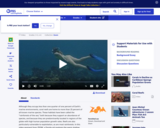
In this video segment, ZOOM guest Cassie takes us on a tour of the coral reef near her home in Key Largo, Florida, and points out some of its unique features.
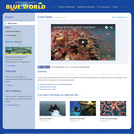
In this video, Jonathan examines the biology of coral reefs and their importance to the marine ecosystem. Please see the accompanying lesson plan that discusses pH and ocean acidification for educational objectives, discussion points and classroom activities.